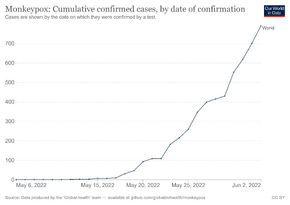Monkeypox virus
| Monkeypox virus | |
|---|---|

| |
| Electron micrograph of Monkeypox virus | |
| Virus classification | |
| (unranked): | Virus |
| Realm: | Varidnaviria |
| Kingdom: | Bamfordvirae |
| Phylum: | Nucleocytoviricota |
| Class: | Pokkesviricetes |
| Order: | Chitovirales |
| Family: | Poxviridae |
| Genus: | Orthopoxvirus |
| Species: | Monkeypox virus
|
Monkeypox virus (MPV or MPXV) is a double-stranded DNA virus that causes monkeypox in humans and other animals.[1] It belongs to the genus Orthopoxvirus in the family Poxviridae.[1] It is one of the human orthopoxviruses that includes variola (VARV), cowpox (CPX), and vaccinia (VACV) viruses. It is not a direct ancestor to, nor a direct descendant of, the variola virus, which causes smallpox. Monkeypox disease is similar to smallpox, but with a milder rash and lower mortality rate.[2][3]
Variation in virulence of the virus has been observed in isolates from Central Africa, where strains are more virulent than those from Western Africa.[4] The two areas have distinct clades of the virus, termed Congo Basin (Central African) and West African clades.[5][6]
Genome
In terms of the genome of the Monkeypox virus we find that it is 200 kb in size and encodes around 200 proteins.Furthermore, it resembles the monkeypox international outbreak (genomes) of 2017-18 and differs from one of these sequences by fewer than 100 nucleotide bases (out of 197,000 NUC).[7][8]

Transmission
The virus can spread both from animal to human and from human to human. Infection from animal to human can occur via an animal bite or by direct contact with an infected animal’s bodily fluids. The virus can spread from human to human by both droplet respiration and contact with fomites (touchable surfaces) from an infected person's bodily fluids. The incubation period is between 10 and 14 days. Prodromal symptoms include swelling of lymph nodes, muscle pain, headache, fever, prior to the emergence of the rash.[9]
Reservoir

Monkeypox is carried by animals including primates. It was first identified by Preben von Magnus in Copenhagen, Denmark, in 1958 in crab-eating macaque monkeys (Macaca fascicularis) being used as laboratory animals.[10]
The 2003 outbreak in the United States was traced to prairie dogs infected from an imported Gambian pouched rat from Ghana.[11]
Monkeypox virus causes the disease in both primates and in other animals. The virus is mainly found in tropical rainforest regions of central and West Africa.
Epidemiology


The virus is mainly found in the tropical forests of Central Africa and West Africa. It was first discovered in monkeys in 1958, and in humans in 1970. Between 1970 and 1986, over 400 cases in humans were reported. Small viral outbreaks with a death rate in the range of 10% and a secondary human-to-human infection rate of about the same amount occur routinely in equatorial Central and West Africa.[12]
The primary route of infection is thought to be contact with the infected animals or their bodily fluids.[12]
The first reported outbreak outside Africa occurred in 2003 in the Midwestern United States in Illinois, Indiana, and Wisconsin, with one occurrence in New Jersey. No deaths occurred.
See also
References
- ↑ 1.0 1.1 "Multi-country monkeypox outbreak in non-endemic countries: Update". www.who.int. 29 May 2022. Archived from the original on 30 May 2022. Retrieved 30 May 2022.
- ↑ Alkhalil Abdulnaser; Hammamieh Rasha; Hardick Justin; Ichou Mohamed A; Jett Marti; Ibrahim Sofi (2010). "Gene expression profiling of monkeypox virus-infected cells reveals novel interfaces for host-virus interactions". Virology Journal. 7: 173. doi:10.1186/1743-422X-7-173. PMC 2920256. PMID 20667104.
- ↑ Shchelkunov SN, Totmenin AV, Safronov PF, Mikheev MV, Gutorov VV, Ryazankina OI, Petrov NA, Babkin IV, Uvarova EA, Sandakhchiev LS, et al. (2002). "Analysis of the monkeypox virus genome". Virology. 297 (2): 172–194. doi:10.1006/viro.2002.1446. PMID 12083817.
- ↑ Breman JG, Kalisa R, Steniowski MV, Zanotto E, Gromyko AI, Arita I (1980). "Human monkeypox, 1970-79". Bull World Health Organ. 58 (2): 165–182. PMC 2395797. PMID 6249508.
- ↑ Osorio, J.E.; Yuill, T.M. (2008). "Zoonoses". Encyclopedia of Virology. pp. 485–495. doi:10.1016/B978-012374410-4.00536-7.
- ↑ "Multi-country monkeypox outbreak in non-endemic countries". World Health Organization. Archived from the original on 22 May 2022. Retrieved 22 May 2022.
- ↑ Staff, NCBI (26 May 2022). "Monkeypox virus: Complete genome from the current outbreak now available in GenBank". NCBI Insights. Archived from the original on 9 August 2023. Retrieved 1 January 2024.
- ↑ 8.0 8.1 "Monkeypoxvirus genome ~ ViralZone". viralzone.expasy.org. Archived from the original on 2024-01-01. Retrieved 2024-01-01.
- ↑ "CDC | Questions and Answers About Monkeypox". Cdc.gov. Archived from the original on 2013-03-28. Retrieved 2013-06-15.
- ↑ Reed Business Information (30 November 1978). New Scientist. Vol. 80. Reed Business Information. pp. 682–. ISSN 0262-4079. Archived from the original on 27 May 2022. Retrieved 3 June 2022.
- ↑ "2003 U.S. Outbreak Monkeypox". CDC. 11 May 2015. Archived from the original on 15 October 2017. Retrieved 15 October 2017.
- ↑ 12.0 12.1 Meyer, H.; Mathilde Perrichot; Markus Stemmler; Petra Emmerich; Herbert Schmitz; Francis Varaine; Robert Shungu; Florimond Tshioko; Pierre Formenty (2002). "Outbreaks of Disease Suspected of Being Due to Human Monkeypox Virus Infection in the Democratic Republic of Congo in 2001". Journal of Clinical Microbiology. 40 (8): 2919–2921. doi:10.1128/JCM.40.8.2919-2921.2002. PMC 120683. PMID 12149352.
External links
- CDC Questions and Answers About Monkeypox Archived 2015-05-08 at the Wayback Machine
- CDC –Human Monkeypox – Kasai Oriental, Zaire, 1996–1997 Archived 2022-05-23 at the Wayback Machine
- CDC – Outbreak of Human Monkeypox, Democratic Republic of Congo, 1996 to 1997 Archived 2010-08-04 at the Wayback Machine
- CDC Preliminary Report: Multistate Outbreak of Monkeypox in Persons Exposed to Pet Prairie Dogs Archived 2013-09-25 at the Wayback Machine
- National Library of Medicine - Monkeypox virus Archived 2016-03-06 at the Wayback Machine
- Virology.net Picturebook: Monkeypox Archived 2005-10-28 at the Wayback Machine
- Viralzone: Orthopoxvirus Archived 2010-06-13 at the Wayback Machine
- Virus Pathogen Database and Analysis Resource (ViPR): Poxviridae